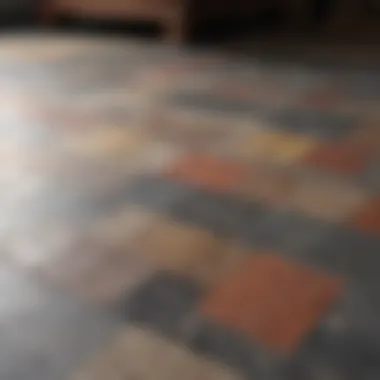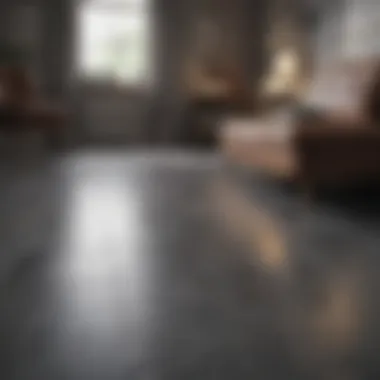Calculating Price Per Square Foot for Flooring


Intro
Calculating the price per square foot for flooring is essential for homeowners and real estate professionals alike. This method not only helps in budgeting for renovations but also for future property valuations. With numerous flooring options on the market, understanding the costs associated with each type can significantly influence purchasing decisions. This guide provides a roadmap for navigating through the intricate calculations involved in determining the price per square foot. By emphasizing the importance of precise measurements, identifying various materials, and analyzing the pricing structures, readers will gain valuable insights into the flooring market.
Home Features
The features of a house can significantly influence the choice of flooring. Distinct architectural styles can dictate preferred materials, while unique design elements can challenge conventional flooring selections.
Architectural Influences
Architecture plays a critical role in determining suitable flooring. For example, homes with a modern aesthetic may benefit from sleek, minimalist surfaces such as polished concrete or laminate. Conversely, a classic Victorian structure might call for traditional hardwood or elegant tile. The choice of flooring can enhance or detract from the architectural integrity of the home.
Unique Design Elements
Beyond architectural styles, unique design elements contribute to the flooring selection. Open-concept layouts might require durable, versatile flooring that withstands high foot traffic. Textured flooring may suit eclectic spaces, while minimalist designs might focus on uniformity and simplicity. When considering flooring, it’s essential to assess how these elements work harmoniously with overall interior design.
Material Considerations
The market is flooded with flooring choices, each varying in cost, durability, and aesthetic appeal. Understanding the price per square foot for these materials ensures informed decisions.
Common Flooring Types
Here are some of the most popular flooring types:
- Hardwood: Offers warmth and durability but may come at a higher price.
- Laminate: A cost-effective alternative that mimics wood but is less durable.
- Tile: Available in different sizes and patterns; tiles often present a mid-range to high cost depending on material.
- Vinyl: Affordable and versatile, great for various spaces.
- Carpet: Provides comfort and warmth but requires more maintenance.
Associated Costs
When calculating price per square foot, it is vital to consider additional costs such as:
- Installation Fees: Professional installation can add considerable expense.
- Material Upgrades: Higher-quality materials typically increase costs.
- Maintenance: Long-term upkeep can affect overall value.
"Accurate measurements are the cornerstone of an effective flooring budget."
The End
In summary, calculating the price per square foot for flooring encompasses understanding various materials, determining associated costs, and appreciating architectural and design factors. As homeowners or real estate professionals navigate this detailed process, they equip themselves with knowledge to make sound decisions, ultimately leading to successful flooring investments.
Understanding Price Per Square Foot
Understanding the concept of price per square foot is essential in the realm of flooring. It serves as a crucial metric for budgeting and comparison shopping. This guide will delve into the significance of knowing how to correctly calculate the price per square foot for flooring options. Accurate calculations help avoid unnecessary expenses and ensure that you invest wisely in your home renovations or real estate transactions.
Definition of Price Per Square Foot
Price per square foot is a financial term that refers to the cost of flooring materials expressed in terms of price for each square foot. This measurement allows buyers and installers to evaluate and compare different flooring options effectively. Knowing the price per square foot helps to quantify expenses, enabling homeowners to make better financial decisions based on their specific needs and budgets.
Importance of Accurate Calculation
An accurate calculation of price per square foot is vital for several reasons. First, it aids in establishing a realistic budget. By knowing the cost of flooring materials in relation to the area of your space, you can project a more precise budget. This prevents overspending and allows for better allocation of resources across other renovation tasks.
Second, it facilitates informed decision-making. When you understand the price per square foot, you can evaluate different flooring types against each other. This aspect is particularly crucial if you are considering various materials with differing costs and aesthetics. The calculation becomes a vital aspect to ensure you make a choice that aligns with both your taste and finances.
"Knowing the price per square foot is not just beneficial; it is necessary for making informed looks into expenses."
Lastly, precise calculations help in negotiation with contractors and flooring suppliers. When you possess the knowledge and data of what you’re entitled to pay, you are less likely to be misled. Clear expectations and understanding can make a significant difference in getting the best deal possible.
The Calculation Process
Understanding the calculation process is crucial when determining the price per square foot for flooring. This section delves into the steps that lead to accurate pricing, which ultimately assists homeowners and professionals in making informed decisions. An accurate calculation helps avoid unexpected expenses, streamlines budgeting, and ensures the appropriate amount of materials is acquired. Inaccuracies at this stage can lead to overpaying or running out of materials, which can derail renovation projects.
Gathering Measurement Tools


To begin accurately measuring for flooring, it is essential to gather the right measurement tools. Accurate measurements are the foundation for determining flooring costs. Common tools that should be collected include a tape measure, a level, and possibly graph paper for doodling layout designs on site. Furthermore, having a notepad or a digital device for note-taking will help keep track of measurements and calculations.
Key characteristics of measurement tools include:
- Tape Measure: The essential tool for accurate linear measurements. Look for a durable and retractable design, which makes it easy to carry.
- Level: This ensures any surface is even. It helps account for variations in flooring requirements, particularly useful if the existing surface has an incline or decline.
Gathering these tools simplifies the entire measurement process, providing a solid starting point to assess flooring needs.
Measuring the Area
Calculating Length and Width
Calculating length and width is a fundamental step in measuring the area for flooring installation. It is straightforward but essential. The length and width must be measured carefully in feet, as these dimensions provide the basis for the area calculation. Accurate measurements in this step ensure the final square footage is correct, which directly affects the pricing and amount of material required.
The inherent value in it is that this method divides the area into rectangular sections. This is beneficial because it allows for quick calculations and mitigates error.
Unique features of calculating length and width include:
- Easy implementation on standard rectangles and squares.
- Quick to compute once measurements are taken.
However, it can become complex with non-rectangular spaces. Therefore, a methodical approach is essential.
Considering Irregular Shapes
Considering irregular shapes is another significant aspect of area measurement. When spaces do not conform to rectangular or square dimensions, adjustments are necessary. This step contributes to an accurate assessment of the total area needing flooring. It may require dividing the irregular shape into smaller, manageable sections that are rectangular or triangular.
The importance of this process becomes evident as it can greatly influence material quantity and overall costs.
Key characteristics of considering irregular shapes include:
- It requires creative thinking to visualize and measure parts not fitting standard shapes.
- It leads to precise estimations of material costs, reducing waste and saving money over time.
However, it can be time-consuming. Understanding how to tackle these challenges is crucial for successful calculations.
Calculating Total Area
Calculating total area follows the measurements taken for individual sections, whether standard or irregular. To arrive at the total square footage, one must sum all calculated areas. This number is critical because it directly influences the pricing per square foot of the desired flooring.
Performing this calculation correctly helps prevent buying too much or too little flooring material. Additionally, it aids in assessing the overall budget for the project. Following the measurement and area calculation process leads to a solid estimate, ultimately empowering buyers to engage with flooring contractors with confidence.
Factors Affecting Flooring Costs
Understanding the factors affecting flooring costs is crucial for anyone considering a flooring project. This knowledge enables homeowners, designers, and real estate professionals to budget effectively and make smarter choices. It is not simply about the price of the material; it involves several dimensions that can influence the total expenditure.
Material Types
Hardwood
Hardwood flooring is known for its durability and timeless appeal. This type of material can significantly enhance the aesthetic of a space, making it a popular choice for homeowners who desire elegance. One key characteristic of hardwood is its longevity, often lasting for decades with proper care. High-quality hardwood, such as oak or maple, provides excellent returns on investment due to its resilience and added home value. However, the price per square foot can be higher compared to other flooring options. On the downside, hardwood is susceptible to scratches and water damage, which can be disadvantages in high-traffic areas.
Laminate
Laminate flooring represents a more budget-friendly alternative to hardwood. It mimics the appearance of wood, tile, or stone, offering versatility in design without breaking the bank. The key feature of laminate is its ease of installation, often allowing homeowners to undertake the project themselves, thereby saving on labor costs. However, its unique drawback is that, while durable, laminate might not have the same lifespan as natural wood. It can wear down over time and may not add as much value to a property in the long run.
Vinyl
Vinyl flooring has gained popularity due to its affordability and variety of styles. It offers water resistance, making it ideal for kitchens and bathrooms. The key characteristic of vinyl is its softness underfoot, providing comfort for those standing for long periods. A unique feature is its design flexibility, allowing for a plethora of patterns and colors. However, vinyl can be prone to tearing and fading over time, which can diminish its aesthetic appeal.
Tile
Tile flooring is renowned for its durability and low maintenance. It is commonly used in high-moisture areas due to its resistance to water damage. The main advantage of tile is its variety in design and material, including ceramic and porcelain. Tile can provide an upscale look at a reasonable price, depending on the choice of material. Nonetheless, tile installation can be labor-intensive, and the subfloor must be adequately prepared to avoid cracking.


Labor Costs
Installation Fees
Installation fees are a crucial element of flooring costs. They can vary significantly based on material, project complexity, and local labor rates. One key aspect of installation fees is the skill level required. Complex designs or intricate layouts often necessitate experienced professionals, which raises costs. Moreover, installation fees can sometimes include additional charges for preparing the subfloor or removing existing flooring. Understanding these fees can help in budgeting accurately for the entire project.
Regional Pricing Variations
Regional pricing variations can impact labor costs dramatically. Factors like demand for contractors, cost of living, and economic conditions in a specific area play significant roles in determining these prices. For instance, urban areas typically exhibit higher labor costs due to a larger pool of clients and increased demand for skilled workers. Conversely, rural regions may have lower costs but can experience delays related to fewer available contractors. This understanding of regional dynamics can inform decisions about when and where to undertake flooring projects.
Calculating Price Per Square Foot
Understanding how to calculate price per square foot when choosing flooring is essential for anyone engaging in home renovation or real estate transactions. Pricing flooring correctly ensures that you allocate your budget effectively. A precise calculation aids in preventing unexpected expenses during installation and helps in making informed decisions about material choices. By grasping the core elements of price calculation, you’ll appreciate how various influences like material costs and labor expenses interact to form the total price.
Determining Material Cost
The first step in calculating the price per square foot is to determine the material cost. Different flooring options carry varying price points, influenced by factors such as quality, durability, and brand. For example, hardwood floors typically offer elegance and longevity but usually come at a higher price compared to laminate or vinyl options. When considering materials:
- Evaluate Your Needs: Think about what qualities are most important for your project. Are you looking for durability, aesthetics, or budget-friendliness?
- Compare Types: Investigate the pricing of different flooring materials. Hardwood, laminate, vinyl, and tile each have their own costs per square foot.
- Get Samples: If possible, take samples home to see how they might look in your space.
When you have a shortlist, gather prices for each material to get a realistic view of costs involved.
Adding Labor Costs
Once you have determined the material cost, it is crucial to factor in labor costs for installation. Labor can vary significantly based on:
- Experience of Installers: More experienced installers may charge higher rates, but their expertise can lead to better outcomes.
- Complexity of Installation: Some flooring materials require specialized installation techniques. Complex designs or custom layouts may warrant additional fees.
- Regional Costs: Labor prices can vary based on location. Areas with higher costs of living generally have higher labor fees.
It’s beneficial to get quotes from several contractors for installation. Review their breakdown of labor alongside material costs before proceeding.
Final Calculation
With material and labor costs accounted for, you can now finalize your calculation of price per square foot. To do this:
- Summarize Material Costs: Add up all costs associated with the flooring materials you’ve selected.
- Combine with Labor Costs: Add the total labor cost to your material costs.
- Divide by Total Square Footage: Take the overall cost and divide it by the total area you need to cover. This will give you the price per square foot.
For instance, if material costs add up to $2,500 and labor costs are $1,500 for a 1,000 square foot area, the total cost is $4,000. Your price per square foot calculation would be:
[ \textPrice per square foot = \frac40001000 = 4 \text dollars per square foot ]
Remember: Always consider a contingency budget for unforeseen circumstances during installation or purchasing, typically 10-15% of your total budget.
By recognizing how to conduct this calculation, you can ensure smooth project development and manageable costs throughout the flooring selection and installation process.
Common Mistakes in Calculation
When figuring out the price per square foot for flooring, one must consider various factors. Common mistakes can lead to substantial financial losses or disappointments in the final result. Awareness of these pitfalls is crucial for accurate budgeting and proper decision-making. By understanding the frequent errors made, homeowners and enthusiasts can achieve a more precise and informed approach to flooring investments.
Ignoring Waste Factor
One common oversight is failing to account for the waste factor. When installing flooring, some amount of material is usually lost during the cutting and fitting process. Most professionals suggest adding an additional 10% to 15% of the total material needed as a cushion for waste. This calculation will support mitigating discrepancies that arise from mistakes or irregular room shapes.
Ignoring the waste factor can lead to ordering insufficient materials, causing potential delays in the project. Adding this percentage also assists in maintaining aesthetic consistencies, especially with materials like tile or hardwood, which may have color variations from batch to batch. Therefore, always plan for possible waste when establishing your square footage needs to create a more accurate overall price assessment.
Underestimating Labor Costs
Underestimating labor costs is another prevalent mistake. Homeowners often focus on material pricing and overlook the expenses associated with installation. Labor costs can vary significantly based on factors like regional pricing, the complexity of the job, and the experience level of the workforce.
The importance of this aspect cannot be underestimated. Failing to properly assess labor costs may lead to unexpected budget overruns. Be sure to not only receive multiple quotes but also understand the specifics included in each quote. Gathering quotes from various contractors can provide insight into the going rates in your area, which can help in making a balanced decision in contractor selection.
"Consulting multiple contractors is vital to ensure a comprehensive understanding of all costs involved in your flooring project."


Some factors to consider when calculating labor costs include:
- Installation fees: Vary based on complexity and contractor expertise
- Additional work required: Such as floor preparation or repairs can increase costs
- Regional pricing variations: Costs may differ greatly from one location to another
By focusing on these elements, you can prevent unanticipated financial strain and establish a more accurate price per square foot for your flooring project.
Comparing Quotes from Contractors
In any flooring project, comparing quotes from different contractors is crucial. This process doesn't only help in finding the best price; it also allows for a better understanding of the services offered. Each contractor may have unique approaches, pricing structures, and quality assurances. By assessing these factors, homeowners can make informed decisions that align with their budget and expectations.
Importance of Multiple Quotes
Obtaining multiple quotes serves a few significant purposes. Firstly, it provides a broader perspective on market rates. What seems reasonable at first glance may actually be overpriced when compared to other contractors. Additionally, multiple quotes can highlight discrepancies in service offerings.
For instance, some contractors may include additional services like flooring removal or subfloor preparation, while others may charge for them separately. Understanding these variations helps in determining the true cost of the project. Also, when you present more than one quote to a contractor, it can sometimes lead to negotiations. A contractor may lower their price or offer better terms to win your business.
- Identifying Trends: Regularly obtaining multiple quotes enables you to identify any trends in pricing over time, helping in future projects.
- Evaluating Contractor Credibility: Comparing quotes allows assessing contractor credibility based on their pricing, timelines, and reviews from other clients.
Analyzing Quotes Critically
Once multiple quotes have been gathered, the next step is a critical analysis of each estimate. This involves more than just looking at the final number. Break down each quote into its components to assess where the money goes. A clear comparison can unveil cost-saving opportunities and value-added services.
Consider the following factors when analyzing:
- Material Costs: Look closely at the materials specified in each quote. Are they the same grade, or is one contractor offering lower quality materials to cut costs?
- Labor Costs: Understand how labor hours are estimated. Some contractors may have higher hourly rates, but they may also be more efficient.
- Timeline: Check how long each contractor estimates the project will take. A longer time may mean higher labor costs than planned.
- Warranty: Evaluate what kind of warranty is offered. It is critical to ensure that any contractor offers a reasonable period of service guarantee.
- Reputation and Reviews: Go beyond the quote and research each contractor’s reputation. Look into third-party reviews or ask for references to gain insight into their work ethic and reliability.
"An well-analyzed quote reveals the true value behind a budget. Ensure all components are understood before making decisions."
In summary, comparing quotes is not merely about finding the lowest price; it is about understanding what you are paying for and ensuring you receive the best overall value. This thorough analysis builds a foundation for transparency and trust between homeowners and contractors.
Long-Term Cost Considerations
When investing in flooring, it is vital to think about long-term costs. The purchase price is often not the only expense to consider. Long-term costs can affect the total investment significantly, sometimes making a less expensive option more costly in the long run. The two key factors in this analysis are the durability of materials and maintenance and repair costs.
Durability of Materials
Durability is an essential factor when selecting flooring. Some materials are better equipped to withstand wear and tear than others. For instance, hardwood flooring is known for its longevity, often lasting decades if properly cared for. On the other hand, vinyl or laminate might need replacement sooner due to damage or fading.
To consider durability, evaluate the following:
- Traffic Levels: Higher foot traffic areas, like hallways or living rooms, require tougher materials.
- Environmental Factors: Areas prone to moisture, like bathrooms, should utilize materials resistant to water damage.
- Impact of Installation Quality: Professional installation may enhance the overall durability of the flooring.
Opting for durable materials can result in lower costs over time, as they often do not require frequent replacement. Investing in higher quality flooring can lead to better long-term value.
Maintenance and Repair Costs
Even durable floors require regular maintenance and occasional repairs. Different flooring types come with various maintenance tasks and costs. The following considerations are most important:
- Cleaning Requirements: Some materials require specialized cleaning products or techniques, increasing maintenance costs.
- Repair Costs: Damage can happen, and repairing costs can vary. For example, a scratched hardwood floor might need refinishing, whereas a vinyl floor may only need a simple patch.
- Long-Term Maintenance Costs: Calculate the expected maintenance costs over the lifespan of the material. This can provide clearer insights into long-term budgeting for your flooring choice.
"Understanding the broader spectrum of flooring costs can help you make informed choices that fit both your current needs and future plans."
Ultimately, analyzing long-term costs related to durability and maintenance will aid in making choices that align with both aesthetic preferences and financial goals.
Culmination
The significance of the conclusion section in this guide cannot be overstated. It acts as a final summary that encapsulates all the crucial elements discussed throughout the article. Reflecting on the detailed calculations and considerations for price per square foot in flooring, it helps solidify the reader's understanding.
Additionally, the conclusion emphasizes the benefits of being thorough in the calculation process. Concentrating on key factors like material types, labor costs, and possible hidden expenses ensures informed decision-making, which is essential for anyone investing in flooring. Taking the time to grasp these concepts may save considerable costs in the long run.
Understanding how to calculate price-per-square-foot accurately ultimately leads to smart budgeting and informed choices—qualities that are vital for any homeowner, designer, or real estate professional.
Recap of Key Points
- Accurate Measurements: Always measure the area before calculating costs.
- Material Types: Different materials come with varying costs and qualities. Know your options.
- Labor Costs: Include labor in your calculations to get the total expense.
- Common Mistakes: Be aware of potential pitfalls like ignoring waste factors.
- Long-Term Considerations: Think not just about initial costs, but also about durability and maintenance.
Final Thoughts on Pricing
Pricing in flooring is more than just numbers—it reflects quality, aesthetics, and long-term value. The knowledge gained from this guide equips you to navigate the complexities of flooring costs intelligently. When planning your flooring project, take these insights into account, and remember that thorough research can lead to rewarding outcomes, both financially and aesthetically. Stay informed, and make decisions that serve you well in the long term.



